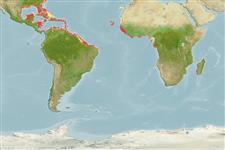Hexacorallia |
Scleractinia |
Rhizangiidae
Environment: milieu / climate zone / djupintervall / distribution range
Ekologi
Revassocierade; djupintervall 0 - 40 m (Ref. 847). Subtropical; 34°N - 5°S, 98°W - 12°E (Ref. 847)
Atlantic Ocean.
Length at first maturity / Size / Weight / Age
Könsmognad: Lm ? range ? - ? cm Max length : 0.3 cm CORD hane/ej könsbestämd; (Ref. 847)
Appears as uniform light brown colonies that are massive, usually less then 300 mm across and sometimes occur as free-living mobile balls. Corallites are rounded, deep and irregular about 2.5-3 mm diameter. Septa are in clearly defined three cycles.
Zooxanthellate (Ref. 116012). Found on shallow reef (Ref. 847).
Life cycle and mating behavior
Könsmognad | Reproduktion | Lek | Eggs | Fecundity | Larvae
Either gonochoric or hermaphroditic (Ref. 113712). Mature gametes are shed into the coelenteron and spawned through the mouth. Life cycle: The zygote develops into a planktonic planula larva. Metamorphosis begins with early morphogenesis of tentacles, septa and pharynx before larval settlement on the aboral end (Ref. 833).
Cairns, S.D., D.R. Calder, A. Brinckmann-Voss, C.B. Castro, D.G. Fautin, P.R. Pugh, C.E. Mills, W.C. Jaap, M.N. Arai, S.H.D. Haddock and D.M. Opresko 2003 Common and Scientific Names of Aquatic Invertebrates from the United States and Canada: Cnidaria and Ctenophore, Second Edition. American Fisheries Society Special Publication, no,28. XI+115. With CD-ROM. (Ref. 1663)
IUCN Red List Status
(Ref. 130435: Version 2025-1)
CITES status (Ref. 108899)
Not Evaluated
Threat to humans
Human uses
| FishSource |
Verktyg
Ytterligare information
Trophic EcologyFood items (preys)
Födosammansättning
Födointag
Predatorer
Population dynamicsTillväxt
Max. ages / sizes
Length-weight rel.
Length-length rel.
Length-frequencies
Mass conversion
Abundans
PhysiologySyreförbrukning
Human RelatedStamps, coins, misc.
Internet-källor
Estimates based on models
Preferred temperature
(Ref.
115969): 24.1 - 28, mean 26.8 (based on 304 cells).
Fishing Vulnerability
Low vulnerability (10 of 100).
Price category
Unknown.
